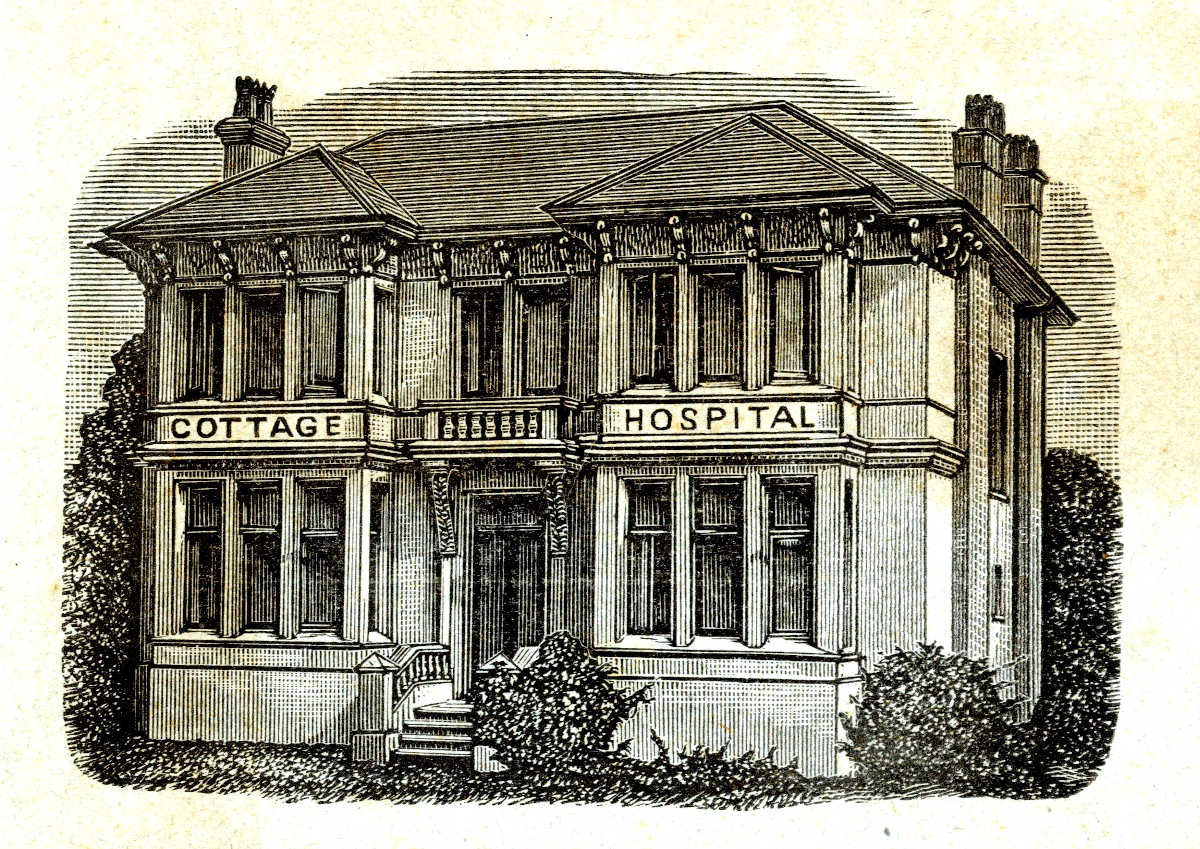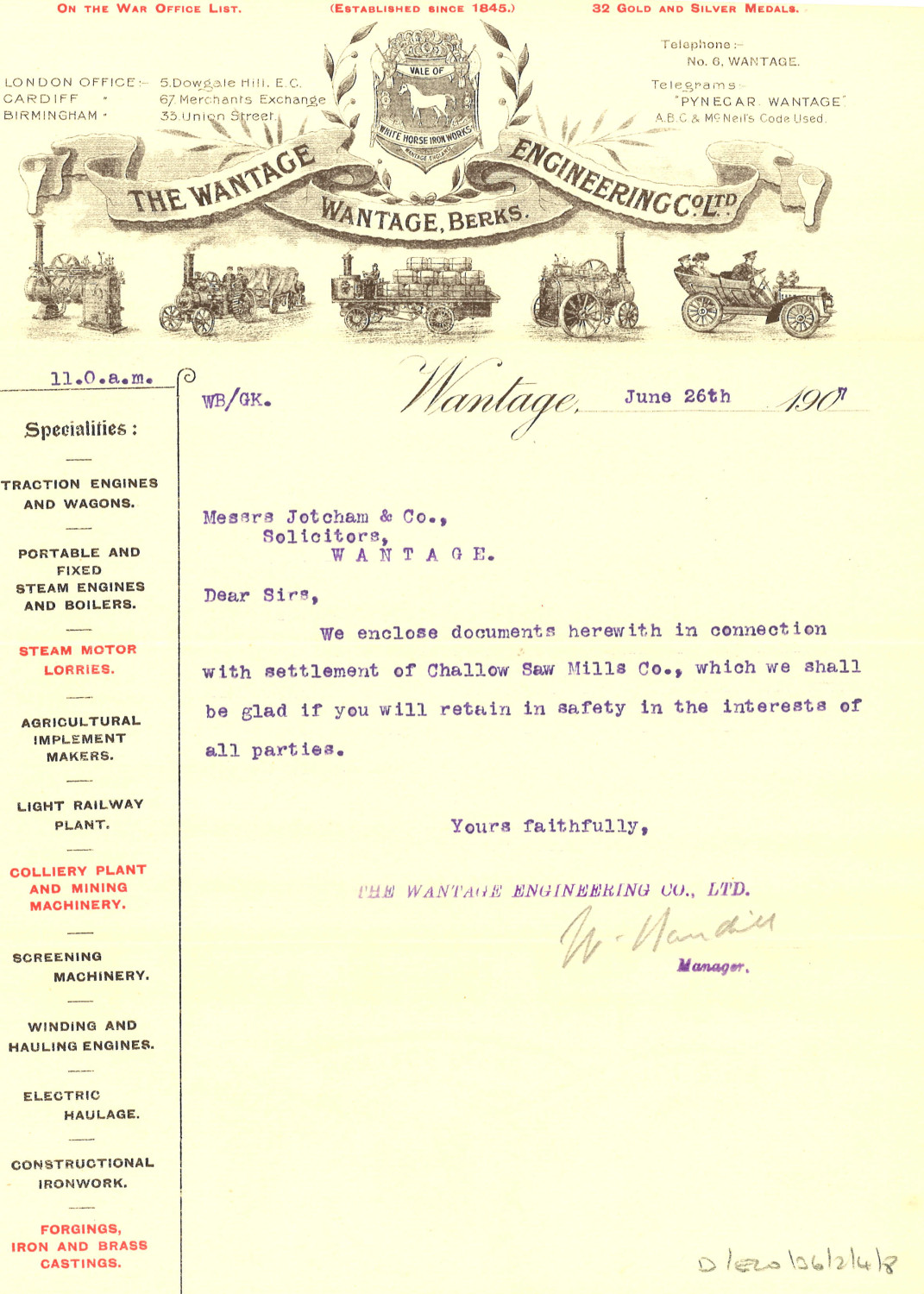We have recently completed cataloguing the records of another defunct Berkshire solicitor, M K Collard of Wantage, formerly Jotcham & Co (collection reference D/ECO) and in this article, we take an in-depth look at just what the collection holds.
The firm was founded by Llewellyn Jotcham (1830-1905). He was originally from Wotton under Edge, Gloucestershire, but moved to Berkshire and by the time he was 20 he was the clerk to Wantage solicitor William Dowell Wasbrough (1808-1888). At some point between 1850 and 1869 he became a solicitor himself in private practice. Llewellyn was joined (and after his death in 1905) succeeded in business by his son William Clarke Jotcham.
In 1953 Jotcham & Co was renamed William Hedges & Collard, and in 1896 it became M K Collard & Co. It later became Collard Chamberlain, and closed down in the early 1960s.
Some papers in this collection are personal ones of the Jotcham family and their connections. Llewellyn Jotcham married Catherine Molyneux Clarke in 1864, and the collection includes a draft of their marriage settlement (D/ECO/F1/1) and settlements for various members of her family. Born in 1835, Catherine was the daughter of local landowner William Nelson Clarke of Ardington and granddaughter of William Wiseman Clarke, High Sheriff and Deputy lieutenant of Berkshire; her maternal grandfather was Sir Thomas Molyneux of Castle Dillon, Ireland. Catherine’s brother Somerset adopted the surname Wiseman-Clarke in 1873.
However, most of the collection consists of papers of the firm’s clients. They also include papers of the Allin family of East Hendred, 1744-1897 (D/ECO/B1); the Pumfrey family, mostly of Wantage, 1791-1886 (D/ECO/B2); and other families.

Wantage Cottage Hospital: no tramps allowed
The records of Wantage Cottage Hospital are part of this collection as Llewellyn Jotcham was clerk to the committee. The hospital was established in 1884 from a bequest by Percy Smith, and was a charitable institution, although some private patients were treated for a fee. It served the poor of Wantage and district, set out in 1911 as comprising Ardington, Brightwalton, East and West Challow, Charlton, Charney Bassett, Childrey, Chilton, Denchworth, Farnborough, Fawley, Goosey, Grove, East and West Hanney, East and West Hendred, Harwell, Kingston Lisle, Letcombe Bassett, Letcombe Regis, Lockinge, Lyford, Sparsholt and Wantage. Initially it occupied a single house and was very small; a note in the minutes refers to a 'record number' of 11 patients in December 1903. Patient numbers were limited to just 12 (10 ordinary cases and two accident or emergency cases), and no children under 2 except for urgent operations. A new larger building opened in 1927, allowing more patients to be cared for.
The records include minutes of the committee which ran it, 1891-1920, accounts, 1884-1907, and rules, 1911. The minutes include a resolution that no tramps or residents of common lodging houses should be admitted under any circumstances, but that the ambulance might be used to convey such patients to the workhouse infirmary. In 1903 the secretary reported that he had instructed the Relieving Officer to 'exercise proper care in the class of paupers' sent by the workhouse to the hospital, and that tramps could not be admitted 'under any consideration whatever'. There are several references to disputes over whether specific patients should have been admitted, including a man named Giles from East Hendred, who had suffered an injury falling from a roundabout at the fair at Wantage while drunk, 1895; and Mary Ann Barwell, admitted 'in a filthy condition', 1896.
In 1905 the Wantage Engineering Company fitted the operating room with wires free of charge in anticipation of electric light being available at a later date. An outbreak of scarlet fever forced the hospital to close temporarily in 1909. In 1909 the famous Hospital Dog Bruce of Swindon, Wiltshire was used for fundraising. In 1913 there is a reference to Nurse Poulton, an incurable case without means or a home, was admitted to the hospital from Lechlade, Gloucestershire, where she had been employed when she suffered a breakdown from overwork. In 1918 special massage treatment was provided for a wounded soldier from Ardington.
Wantage Engineering Company
Of special interest are records relating to the Wantage Engineering Company, 1881-1921 (D/ECO/B6). This business traces its origins to the ironfounder's business of John Austin of Wantage, founded in 1826. The Vale of White Hourse Foundry was opened in 1847. The firm was later known as Hart, Gibbons & Gibbons, then P & H P Gibbons (c.1860-1881), then Gibbons & Robinson (1881-1891), then as Robinson & Auden Ltd (1891-1900), and finally became Wantage Engineering Company in 1900 under the ownership of Lady Wantage. It was an agricultural engineer and manufacturer, moving in the early 20th century to the manufacture of machines for haulage, railway, mining and conveying. Its own archive is held at the Museum of English Rural Life, University of Reading. The papers here are those of Jotcham & Co as their solicitors. Much of it involves legal cases, mostly for customers’ unpaid debts.
At the period for which we hold records they seem to have specialised in steam threshing machines. William Hyde Barnett of the Staffordshire Steel and Ingot Iron Works, who was seeking appointment as the Wantage Engineering Company's agent, wrote in January 1902 that 'I gather that the Motor-wagon is your leading speciality', and a month later he referred to 'the Lorry being your principal speciality'. He also complained that the proposed agreement would not allow him to sell the company’s products to the Government or to capitalise on the personal connections of the late Lord Wantage.

The firm had customers all over the world, and appointed agents to manage overseas orders. Some of the correspondence gives an insight into wider economic conditions. Debtor Albert Townsend apologised in 1892, 'I am very sorry to have given you so much trouble but it is impossable [sic] to make money'. In 1894 James Humfrey Robinson of Blewbury tried to get out of a debt incurred by his late father Richard, a farmer, who had died in significant debt to many creditors. He wrote a letter stating, 'I had a writ handed to me for your claim due to your firm for repairs done to Engine & Thrashing [sic] Machine, which I know I ordered, but I only did so as agent in which capacity I have always acted on behalf of my late Father... I can assure I never had any business of mine own, never opened a banking account, never had my name put on any waggon, implement, sack, or anything on the farm... If I had brought this on by neglect of business, racing, or foolishly spending money it would be different'.
A case in 1892 sadly involved liability for the death of employee Charles Payne, due to defective machinery and negligence.
Land and buildings
A rare early set of sale particulars is for Barwell Farm, Grove, 1812 (D/ECO/E1/22). Interestingly, it includes building materials from the recently demolished Belmont House, Wantage. Divided into 160 lots, the building materials are set out room by room, and the catalogue is annotated with the prices fetched. Belmont House had been built in c.1763 as the new manor house for the manor of Wantage. There are a number of other sale catalogues for properties in the area, 1897-1952 (D/ECO/E1).
Papers relating to the sale of Sparsholt Court, West Hendred, in 1880, reveal that the potential purchaser had withdrawn from the purchase due to issues with the boundary, and observing that the mill gear was 'in a very bad state, the 3 pair of stones being useless'.
There is a lovely map dated 1754 of the Ham, the Manor of Priorshold, ‘the new broke Lands’ in Grove, the Common Field and Mead of Charlton, and Lattensdowns, Wantage (D/ECO/P1). At the side of the map is a finely drawn and detailed elevation of The Ham, residence of Mr Price, lessee of the manor of Prior's Hold. It was probably for him that this map was made.
The largest part of the collection by volume consists of title deeds (D/ECO/T). These include deeds for a mill, manure works, stables and other buildings built between 1855 and 1873 on an allotment of meadow or pasture land (1 a.) in the former common meadow called White Mead, West Challow. A mortgage of 1873 includes all the machinery, steam engines, boilers, standing and going tackle and gear, etc. (D/ECO/T8/2). In 1688 Sir Edmund Fettiplace of Swinbrook, Oxfordshire, baronet, gave an annuity of £100 charged on North Denchworth House, West Hanney, to his brother Charles for life, to be paid in the south porch of Swinbrook parish church at Michaelmas and Lady Day between 1 and 4 pm, in portions of £50 each (D/ECO/T15/1).
A deed of a capital messuage [mansion] and land at Barwell, Grove, in 1606, forms a post-nuptial marriage settlement of the property by Nicholas Clement on his son John Clement of Farnborough, yeoman, and his wife Anne, daughter of Richard Turrold of Farnborough (D/ECO/T13/1). The deed explains that Nicholas had promised to settle the property on John when he married Anne, instead conveying it to his own use and disinheriting John, but following a Chancery suit brought by John, Anne and her father, he had been forced to give it to the happy couple. Another bundle of Gove deeds includes a bond from Martha Prince of Grove, spinster, promising to pay a pension, provide board and lodging, and pay the medical costs of Isaac Prince of Grove, watchmaker, 1881 (D/ECO/T13/11). He died a couple of years later, and there is also an inventory of the goods at his shop in Grove, 1883.
Other properties are in Abingdon, 1689-1837; Appleton, 1756-1925; Aston Tirrold, 1683; Baulking, 1621-1795; Chaddleworth, 1749-1757; East Challow, 1744-1899; West Challow, 1820-1875; Charney Bassett, 1831-1919; Childrey, 1818-1851; Denchworth, 1805-1901; Drayton, 1688-1856; Grove, 1606-1883; East Hanney, 1621-1877; West Hanney, 1777-1806; Harwell, 1683; East Hendred, 1618-1862; West Ilsley, 1684; Lambourn, 1863; Letcombe Bassett, 1712-1749; Letcombe Regis, 1619-1876; Milton, 1693-1794; North Moreton, 1683; Shellingford, 1795; Shrivenham, 1604-1910; and Wantage, 1691-1877.
Other records
The copy of the will of Thomas Batson of Stepney, Middlesex, esquire, 1700, devises a plantation at Barbados ('Barbadoes') which includes reference to what can only be assumed are slaves (D/ECO/Z2). The collection also includes papers relating to activity on behalf of the Liberal Party in Wantage at the Berkshire County Election [i.e. the election of an MP for the county at the General Election] of 1868 (D/ECO/Z9). These include a partial list of electors with notes of promised votes.
There is also a mortgage by the justices of Berkshire charged on the police rates, to raise money to purchase sites for and build police station houses and strongrooms, 1859 (D/ECO/O1/1).
Finally, the bond of William Arden of Harwell, bodicemaker, indemnifies the overseers of East Hendred from all charges arising from his apprentice Richard Kirsell, a pauper of the latter parish, during the seven year term of the apprenticeship, 1676 (D/ECO/Q2/1).
We are pleased to say that these records are now available for consultation and help expand our knowledge of the Wantage area’s history. You can view the full catalogue online.
